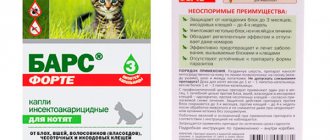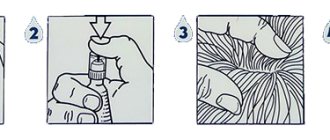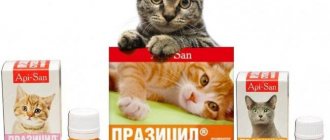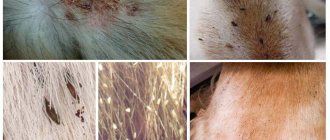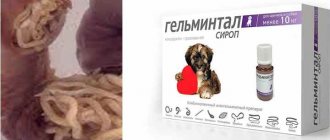How to properly put drops in your dog's ears
A dog is an animal that does not always like such procedures as cleaning and burying its ears.
However, it is worth noting that sometimes there are cases where you simply cannot do without this process and you have to look for all possible ways to persuade the dog to carry out this procedure with the least loss. This is due to the fact that some dog representatives tolerate this process quite calmly, while others simply cannot tolerate outside interference and try to resist their owner in every possible way. It is very important to take into account that in some dogs the head area is quite sensitive, and in some cases even a little painful, therefore, it is first necessary to neutralize the pet using a special muzzle so that it does not start biting or scratching with sharp claws.
It should also be noted that the calmness and pliability of the pet itself depends on how correctly the process of instilling drops is carried out.
How to accustom a dog to the procedure
What to do if your dog won't let you clean your ears? Not all animals have a positive attitude towards hygiene procedures. It's best to gradually introduce your pet to ear cleaning when he's still a puppy. An older dog can be trained to brush just like a young one, and here contact with the owner, especially visual, is extremely important. At first, call the dog to you, stroke its head, touch its ears, and then just let it go. Extend contact daily, touch the ears, lift them, massage them.
Much depends on the breed of the dog. For example, terriers will take longer to get used to than others. After the cleaning is complete, give your dog a treat and reward him for enduring the procedure courageously. The pet will understand that there is nothing wrong with this, and subsequently will willingly agree to all hygienic manipulations.
Some people keep small lap dogs at home and do not let them go outside. But even in such cases, dirt gets into the pets’ ears, and ticks brought in from the street, for example, on the soles of shoes, are also possible. Of course, when a dog is regularly outdoors, the risk of ticks and various infections getting into the ears increases sharply. In addition, even in an ideally healthy animal, dirt and fat deposits accumulate in the ears in any case, and an unpleasant grayish coating forms. It is necessary to examine and clean the ears to get an idea of the general condition of your pet.
It is the color of the ears and their appearance that can say a lot about the health of the dog. For example, redness of the ears and the appearance of dark spots indicate inflammatory processes, a cold, or an allergic reaction to food. It is important to constantly inspect your dog’s ears; do a thorough examination about 2 times a week. Of course, you will also need to carefully clean your ears, not only removing dirt from the outside of the auricle, but also removing plaque accumulations from the inside, penetrating directly into the ear canal. Of course, you need to be very careful, use the right tools and pay close attention to hygiene. Remember the recommendations so that you know exactly how to clean your dog’s ears correctly.
How to behave so that your dog does not worry while cleaning his ears?
Try to create the most comfortable conditions for your four-legged friend, otherwise it will be quite difficult for you to examine the ears, and during cleaning you may make a mistake and cause pain to the dog. Of course, many people know that dogs are quite patient and are accustomed to obeying their owners and following commands. They behave much better than cats during an unpleasant procedure. However, the most well-mannered dog can jerk its head sharply and suddenly deviate to the side if it experiences discomfort. This already creates a threat to the pet’s health, since the ears are easily damaged. Remember a few secrets to ensure that your ear cleaning process goes smoothly.
- Discipline
. Your dog is probably used to walking outside. If you usually take her out on the boardwalk on a leash and wearing a collar, she will already have certain associations with these accessories. Explain to your pet that you need to examine his ears before going for a walk. Put on the collar, fasten the leash, then put on your gloves and get to work. It is better not to wash your hands, because by this time your dog will already be distracted. The dog must understand that wearing a collar and leash requires special discipline from him. He will probably behave well during the examination and cleaning of the ears. - Positive associations
. It is important to make sure your dog understands that a not-so-pleasant procedure will be followed by a joyful event. Let your pet wait for a walk or a treat after cleaning his ears. Don't forget to make your dog happy every time. For example, give a little of your favorite treat, or take your pet out into the yard. - Without much pressure
. Sometimes animal owners prefer to completely fix the dog in a completely motionless position. In this way, they want to ensure maximum safety and prevent possible injuries during the procedure. In fact, you should not put excessive pressure on the animal or completely deprive it of freedom of movement. This will only scare the dog. It is not at all necessary for three of you to gather around the dog and hold him from all sides. All you have to do is gently hold the dog by the head or collar with one hand, or ask one person to do this. - All ours
. It is not worth inviting people who are not members of your family or who are rarely in your home to have your ears cleaned. Let only people who know your pet well attend the procedure. - Caution
. Be extremely careful when inspecting your dog's ears while cleaning them. It is necessary to act carefully, but carefully. Do not try to clean the entire ear canal, and do not insert the cotton swab too deep. Movements should be smooth, quite slow. Avoid any sudden movements, as the ear is easily injured. - Delicacy
. It’s not worth raising your voice at the dog or scolding it if it shows anxiety or prevents you from examining and cleaning its ears. The animal's excitement is understandable. You need to convince the dog that nothing bad is happening.
Please note: you must proceed carefully but confidently.
If you are worried and feel insecure, your fear will be transmitted to the animal. When owners are afraid to clean their dog's ears themselves, it is better for them to consult a veterinarian. The specialist will do everything himself. Tools. Examining a dog's ears
First, you need to prepare all the items necessary for examining and cleaning your ears. Things should be at hand, because going for them later is inconvenient. The dog will be distracted and lose the right mood.
- You will need a collar, you can also attach a leash.
This will let your pet know to behave. - Durable sticks, cotton pads.
Use only strong, long enough sticks. Check them before use so that they do not break at the most inopportune moment. - Small but bright flashlight.
It is better to choose a lantern with a small diameter that resembles a stick. It is with such a flashlight that it is most convenient to inspect the ears. You can easily illuminate your ear with it by moving it along the outer surface of the shell. - Small mirror.
You may also need a mirror to better see the ear canal. In dogs, it has a rather complex shape, so the winding passage is difficult to see. - Ear cleansing ointment, special gel, green tea
or herbal infusion, “sea water” or salt water with calendula tincture. You can clean the ears with plain water, but it must first be boiled and then cooled. Green tea softens the ears well and relieves irritation. An infusion of marshmallow, chamomile, and calendula will also soften the skin, while it has an anti-inflammatory effect, like “sea water.” To prepare it, you need to dissolve a spoonful of soda and salt in a glass of water. Make sure there are no grains left. - A tool to simplify the procedure.
When the dog is quite capricious, it is worth using a special ointment to clean the ears. It's much easier to work with her. You put the ointment in your ears, and then remove it when it spreads into the ears. This method is especially relevant for small lap dogs, which usually do not like such procedures and begin to be capricious. - A treat, a gift.
You need to reward your animal every time you inspect and clean its ears. Then the procedure will evoke only positive emotions in the dog, and the dog himself will begin to wait for the next ear cleaning.
When everything necessary has already been prepared, you can get down to business.
Please note: ears are cleaned thoroughly when they are sufficiently dirty. If there is only a small plaque on the outside of the ear, you can simply remove it and not clean the passage. Cleaning the dog's ears
First, make sure that all the items needed to inspect and clean your ears are in place. Follow the sequence of actions.
- Prepare your dog for examination. Play with your pet. You can “introduce” him to a cotton swab or disk. Let the dog sniff unknown objects, examine them and make sure that they are harmless. Of course, you no longer need to use these chopsticks.
- Put a collar and leash on your dog. This should emotionally prepare the animal for discipline.
- Wash your hands or wear medical gloves. Make sure your dog doesn't get scared when you wear gloves. If unfamiliar things bother her, it’s better to just wash her hands.
- Take a flashlight, a clean dry cotton pad and a stick. Proceed to examine your ears.
- First, pay attention to the auricle. Then carefully examine the ear canal. It's winding, so you may need a mirror.
- If there is not a lot of dirt, it is enough to wipe the auricle with the prepared mixture. Maintain good hygiene.
- When the ears are very dirty, you need to thoroughly clean the auricle. Then gently clean the ear canal. It is better to use ointment, or soak a cotton swab in green tea or herbal infusion. Movements should be smooth and careful. Direct them from the inside of the passage outward in order to remove dirt rather than compact the wax plug.
- Having cleared the ear canal of heavy contamination, you need to remove the plaque from the auricle again. While you were removing the sulfur and plaque from the passage, the sink was also a little dirty.
After cleaning your dog's ears, it is advisable to treat the auricle with a special softening compound, herbal infusion.
Be sure to make your dog happy after the procedure. It is best to treat the animal with its favorite treat. You can also go for a walk when your ears are completely dry.
Very often, owners begin to care for the ears of their charges only after problems arise with them. And sometimes only after an unpleasant fetid odor is heard from the hearing organ. Caring for dog ears is not only hygiene, but also the prevention of hearing diseases. Therefore, we will learn about how to properly clean your pets’ ears.
How to properly put drops in your dog's ears
The feeling of itching in a dog is sometimes so strong that it simply ceases to control its actions and can become quite aggressive.
Therefore, in order to correctly carry out the process of instilling drops, you must first calm the animal and establish the most trusting relationship with it. Some breeders advise swaddling the dog first so that it cannot escape at the most crucial moment, but there is absolutely no need to carry out this procedure. This is due to the fact that the animal will try to escape, which will also be marked by even greater aggressiveness.
It is recommended to drip the dog’s ear exclusively, reinforcing all your actions with affection and other trusting actions. A dog is an animal that has always been distinguished by its special intelligence and intelligence, therefore, if it understands that you are not doing any harm at all, but only want to do better by alleviating the pet’s condition, then it will independently allow such a manipulation as ear drops.
It is also necessary to take into account the fact that, according to the recommendations of veterinarians, drops can be instilled into an animal’s ear only after a preliminary complete cleansing process and elimination of purulent discharge.
Features of pre-rinsing and cleaning the ears of a dog
As mentioned earlier, the preparatory process before instilling the drops includes preliminary cleaning and rinsing. Therefore, in order to properly rinse your dog’s cavities, you need to adhere to the following basic rules:
- The best time to rinse the ears is when you bathe your animal.
- You should first calm the animal down; you should not play active games with it before the process of instilling Otipax drops.
- Before carrying out the cleansing process, you should make sure that the animal takes a fairly comfortable position, preferably if it is a lying position on the floor.
- In order for the sulfur to soften as much as possible, it is worth pre-dropping it with preparations such as hydrogen peroxide or boric alcohol (boric alcohol will be the best option for purification purposes).
- After you have dripped the solution, you should rub the sink near the very base. During the rubbing process, a characteristic squeaking sound should be heard, this will indicate that the drops have reached their destination.
- If your pet's ears are large enough, then before you start cleaning, you should take care to turn the shell outward as much as possible.
- The drops that remain after the wax has softened should be eliminated with a cotton pad and allow the animal to shake its head to completely remove the fluid from the cavity of the auricle.
- In order to clean your dog’s ears as effectively and safely as possible, you should use separate clean cotton pads for each cavity.
- If your pet's ears are very small, then you should not use cotton swabs to clean out droplets of liquid. This product can only push sulfur deep into the cavity, which can cause damage to the eardrum.
- After the cleaning process is completed, you should definitely reward your pet with some kind of treat or play with it.
It should also be noted that the calmness of the animal during the process of instilling Otipax drops into the ears is the key to a successful procedure. Can this be done when the dog is not in a calm state? The answer here is clear - of course not!
What to clean with?
So that there are no questions about how to clean dogs’ ears, you need to remember the variety of products that it is advisable to have in the house:
- sanitary wet wipes - soften wax and dirt and do not cause irritation;
- cotton swabs - they should be used carefully, without causing harm. After all, it often happens that instead of cleansing the ear canal, they push sulfur deeper into it;
- lotion - helps soften secretions and bring them out;
- powder - helps dry the inner skin;
- gauze, hydrogen peroxide, baby lotion and acetic acid - they can also be used for this procedure, following the advice;
- cotton pads - suitable for removing dirty ear formations.
We are looking for a remedy
The key to success and quality of the hearing aid cleaning procedure involves the correct selection of the necessary medications. The simplest and most effective of them is a piece of gauze soaked in water at room temperature.
Lotions for cleaning dogs' ears are popular today. They are based on salicylic, boric and malic acids. In addition, this includes all sorts of useful things, oils, etc. However, you should use the lotion no more than once a month, because otherwise, in addition to cleansing, it can kill beneficial microflora. So before using the lotion, consultation is required. Among the popular such tools, it should be noted: Bars (Russia), Сliny (Russia), TWINS (Russia), Mr. Bruno (Russia-Switzerland), 8in1 (USA), Hartz (USA), Beaphar (Netherlands), Iv San Bernard (Italy), Otifree (France).
No less popular among animal lovers are liquids (usually the same lotions) in the form of a spray solution. The dog ear cleaning spray is easy to use and allows for quick success. Thus, Fitolor-spray ensures a moist condition for the skin of the hearing aid; Aurika spray dilutes dirt and earwax, has a beneficial effect on the mucous membrane of the ear canal; Otomin spray is used for dogs with long drooping ears.
Gels are thicker in composition than lotions. They, due to the fact that they have recently appeared on sale, are not in even greater demand. But the advantage of this product is that it does not contain alcohol. Therefore it practically does not exist. And if there are any, then there are much fewer of them than, say, lotions. But the effect of their use is much higher. However, such gels are not recommended to be used together with medications containing iodine.
There are creams, pastes and powders that can help you clean your pet's ears. The choice is up to you and your veterinarian's advice. Pets are completely dependent on their owner. And therefore there is no need to experiment on them. Just treat the problem with understanding and eliminate it using available means.
Otitis media in dogs: identifying symptoms and treating them at home
Due to the specific structure of the ear, dogs are often susceptible to otitis media. Inflammation of the middle ear in dogs is often diagnosed; internal and external are less common.
The disease causes discomfort and severe pain to the pet. A visit to the veterinarian will help free the dog from uncomfortable sensations and prevent it from developing into a chronic form. An advanced disease can develop into complete deafness and provoke the death of a pet.
Root causes of otitis media
Otitis in a dog occurs for several reasons:
- Ear mites are a common cause of ear inflammation in dogs. Infection is possible from infected animals.
- A tumor becomes a provocateur of otitis media if it clogs the ear canal and interferes with the “ventilation” of the ear.
- Allergies to food, treats, medications and shampoo can lead to ear disease in your dog.
- A foreign object lodged in the ear. Often plant seeds, midges or blades of grass get into the ear, thereby causing otitis media in the dog.
The disease often develops due to insufficient care of the pet’s ears, but it also happens the other way around: excessive cleaning of the ears leads to the destruction of the protective layer, sebum and wax secretions.
The cause may also be weak immunity, bad teeth and hormonal imbalance.
Predisposition of certain breeds to otitis media
Some breeds are more prone to this disease. Most often - dogs with large drooping ears: cocker spaniel, basset hound, dachshund and others. Drooping ears obscure the auditory opening and interfere with “ventilation,” which creates a “paradise” for the reproduction and life of pathogenic microbes.
East European Shepherds also often suffer from this disease. The structure of the ear does not prevent the penetration of dust and microorganisms into it.
Dogs with expressive folds on the muzzle, active swimmers, and those who live in high humidity climates are also at risk.
Symptoms
The owner can easily recognize the first symptoms of otitis media in a dog:
- often shakes his head, claws at the sore ear and reacts to touching it;
- upon examination, discharge with an uncharacteristic odor and swelling are noticeable;
- the ear is hot to the touch;
- The dog lies down more and turns away from the food.
If you notice such symptoms, you should consult a doctor.
Diagnostics
During the examination, the doctor visually assesses the signs of otitis in the dog: the condition of the ears, nasopharynx, mouth and eyes. At the same time, asking questions about feeding, vaccinations and existing pathologies.
Be sure to have scrapings, ear discharge and blood tested. Laboratory tests will show the number of bacteria and parasites and determine their adaptability to medications. They will also determine your general condition and the possibility of allergies.
In some cases, radiography is used. This happens if the research is not informative enough. It shows the presence or absence of tumors and polyps in the nasopharynx. It is also possible to conduct a CT or MRI to exclude the possibility of brain inflammation. Some manipulations can be performed under general anesthesia.
Therapy is prescribed only based on test results. A specialist should tell you how to cure otitis media in a dog. Otherwise, the treatment will not bring results and will worsen the situation.
Treatment at home
If otitis media is detected in dogs, how to treat it at home? At first, you can alleviate your pet’s condition at home.
As home measures you can use:
- If there is severe scratching, the inner surface of the ear is wiped with hydrogen peroxide and carefully dried with a gauze bandage. Scratches are lubricated with brilliant green.
- If pus has accumulated and the ear “squishes,” you should carefully clean it with boric alcohol, blot it dry and cover it with streptocide powder.
- Dark plaque can be caused by mites. In this case, the auricle is freed from wax accumulations and lubricated with phenothiazine.
Manipulations should be carried out extremely carefully so as not to cause irritation in the affected areas.
Remember that self-treatment of otitis in a dog can lead to serious complications. Therefore, contacting a veterinarian is an important step.
How to clean a dog's ears, care products
To carry out an independent ear cleaning procedure, you need to buy special products from a veterinary pharmacy:
- wet wipes soaked in liquid that dissolves dirt. Choose products that are also suitable for sensitive skin so that the animal does not experience irritation;
- cotton swabs, also soaked in the solution, will help in cleansing the inside of the ear;
- ear lotions with moisture-absorbing properties. They will not only provide a cleansing effect, but will also collect impurities. The wax will be easily removed from the ear, and the animal will not experience any discomfort;
- cleaning powder. It absorbs excess moisture, thereby preventing liquid from accumulating, promoting the formation of fungus. In addition, the ventilation of the auricle improves.
Many dog owners are interested in whether it is possible to clean their dog’s ears with peroxide at home? This product is suitable if you don’t have special solutions at hand. The drug is injected into the ear canal using a syringe without a needle or syringe. For each ear, 3–5 ml will be enough. Peroxide can also cope with unpleasant odors.
How else can you clean your dog's ears at home? In addition to the above remedies, a solution of Chlorhexidine, herbal infusions from marshmallow root, lavender, burdock, chamomile, and sea salt are suitable. Do not use shampoo, vinegar, alcohol or oils to clean your ears.
Drops for otitis media
For the complex treatment of fungal otitis, drugs are prescribed that include miconazole, clotrimazole or nystatin.
The following anti-otitis drops for dogs are recommended for use:
- Surolan is an antimicrobial, anti-inflammatory and antiparasitic agent. You can use 3-5 drops twice a day. The course of treatment is 2-3 weeks.
- Aurizon fights bacteria and fungi. Apply 10 drops once a day for 1 week; if the symptoms do not disappear, the treatment is extended for the same period. Contraindicated for bitches expecting puppies.
- Otonazole is an antipruritic, antifungal agent. Use 3-5 drops once a day for 2 weeks.
- If the inflammation is caused by an allergen, antihistamine ear drops for dogs are used for otitis media.
- Sofradex – 2-3 drops, 3-4 times a day. Helps very well with swelling and itching.
- Anauran – 5 drops, 2-4 times a day. Indispensable for swelling and itching.
Treatment for suppurative otitis media in dogs is best done with antibiotic ear drops for dogs.
- Otibiovet – 4-5 drops. At the beginning of the development of the disease 3-4 times a day, after 3 days 2-3 times.
- Otipax – 4 drops, apply 2-3 times a day for ten days.
- Anandin , the dose here depends on the size of the pet. Dwarf breeds need 3 drops, medium breeds need 4 drops, and large breeds need 5 drops. The medicine is used for 3-4 days twice a day. It is required to repeat the course in a week, unless otherwise prescribed by your doctor.
The parasitic form requires treatment with insectoacaricidal agents.
- Leopard - 3 drops for dwarf dogs, 4 drops for medium-sized dogs and 5 drops for large dogs. Treatment is carried out twice with an interval of a week.
- Amitrazine is used once a day with an interval of 3 days. The procedure must be carried out until the signs disappear.
Most common drops
It is necessary to begin accustoming the animal to ear hygiene procedures from an early puppyhood, then in the future the dog will be protected from many diseases of the hearing organs. You need to clean your ears at least once every 14 days, using various drops, lotions, and sprays. The external auditory canal is very carefully and carefully cleaned of dirt, sulfur plaque, crusts and secretions.
In the departments of pet products, there are many veterinary drops for cleaning and treating ears, and domestic analogues are in no way inferior in effectiveness to foreign products.
There are 2 groups of ear medications:
- Medicinal – have antifungal, anti-inflammatory, antimicrobial and antiparasitic properties. They help quickly get rid of ear mites, otitis media, and ear hematomas.
- Means used as prophylaxis (hygienic reading and treatment of the hearing organs).
Ear drops, lotions and sprays contain active ingredients such as:
- antibiotics;
- extracts of medicinal herbs;
- hormones;
- essential oils;
- substances of non-steroidal origin;
- insectoacaricidal agents;
- alcohol.
Thanks to their rich composition, preparations for cleaning and treating ears can fight not only bacteria, mites and fungi, but also help wounds, cracks, and ulcers heal faster. However, only a veterinarian is competent to select a safe and highly effective drug, as well as prescribe the exact dosage. Before instilling medicine into dogs, be sure to visit a specialist.
Dekt drops
Dekta ear drops are used for otitis caused by microbes and fungi, notoedrosis and otodectosis. The veterinary product has a complex effect and is suitable only for medicinal purposes. Drops help eliminate foul odor, help relieve itching and pain, and start the process of skin regeneration. It is prohibited to use by puppies under one month of age, whelping and lactating bitches, dogs with infectious diseases, as well as weak and malnourished animals.
Surolan
Drops have a wide spectrum of action. They destroy gram-positive and gram-negative microorganisms, fungi, and have anti-inflammatory, antiparasitic, antiallergic and anesthetic properties. For dogs with otitis media, 3 drops of the drug are dripped into each ear 2 times a day.
Treatment with medications
Let's look at several effective schemes for treating otitis media in a dog. The proposed life examples will help you navigate and build the right treatment for your pet.
Option 1
Patient: large dog, weight 40 kg, age 4 years. Owner's complaints: does not allow petting on the head, the dog's ear hurts. Diagnosis: exudative otitis externa.
- Hydrogen peroxide. Using a damp swab, wipe the inside of the ear and the passage. Cleansing from crusts, pus and excess sulfur.
- Chlorhexidine. Wipe the ear treated with peroxide twice a day for half a month.
- Bepanten. Apply the ointment to the inside of the ear 2 times every 24 hours, for a course of two weeks. In severe situations, it is allowed to use Fluorocort or Lorinden.
- Sofradex - inject 3-5 drops into both ears twice a day for 14 days.
- Sinulox or Clamoxil. Inject into the thigh once in the morning, 5-7 days, 4 ml.
- Suprastin. In the withers - inject 1 ml in the morning and evening - a weekly course.
- Serrata. It is necessary to inject 1 pill twice with an interval of 12 hours – 10 days.
Option 2
Patient: male, age – 7 years, weight – 12 kg. Owner's complaints: the dog is restless, his ear is leaking. Diagnosis: purulent otitis media in the chronic stage.
- Peroxide - twice a day, two weeks.
- Chlorhexidine - twice a day treatment for up to two weeks.
- Bepanten - twice a day for two weeks.
- Sofradex – 3-5 drops every 12 hours. The course of treatment is two weeks.
In a difficult situation, the following mixture of drops is acceptable:
Ceftriaxone 1 bottle + Dioxidin 10 ml + 5 ml Novocaine 0.5% + Suprastin 2 ml + Dexomethasone 3 ml + vitamin B12 2 ml + Dimexide 0.5-1 ml. This suspension should be administered 3-5 drops into both ears with a 12-hour interval. The course of treatment lasts 14 days.
At night, you need to apply a gauze swab soaked in the mixture: 2 ml of Lincomycin, 1 ml of Dexamethasone, Suprastin 1 ml and Novocaine 2% 3 ml. Treatment should continue for 10 nights.
- Sinulox – intramuscularly 3 ml once, course of treatment – a week. Let’s say 1 bottle of Cefogram is mixed with Lidocaine 8 mg. Inject 2.5 ml of the prepared drug 1-2 times a day.
- Suprastin - inject 0.5 ml into the outer thigh, morning and evening for 7 days.
- Serrata - twice a capsule - no longer than 10 days.
- Liarsin – 1 pill 2 times a day – 10 days.
- Mezim – take 1 capsule twice a day for 12-14 days.
A blockade with novocaine at the root of the ear may also be useful. For this, novocaine 05% is used, 7 ml twice a day. Treatment duration is 1 week.
Antibiotics for otitis in dogs should be taken with caution, for example, if the eardrum is damaged, drops containing an ototoxic antibiotic are contraindicated.
What to do
It is recommended that you check your pet regularly. Do this at least 2 times a week. You will need to carefully and properly clean the ears, ridding them of dirt from the outside and from accumulations from the inside. To do this, you will have to penetrate directly into the ear canal.
You need to act correctly and carefully, without causing pain to the puppy or adult pet. When cleaning at home, you need to use special tools. You need to know some recommendations that will help you clean your ears quickly and effectively.
For your pet, create conditions that will be as comfortable as possible for him. Otherwise, examining the ears will be difficult, and cleaning will be accompanied by errors and pain.
Naturally, many people know the patience of a pet. But even a well-mannered dog is capable of jerking its head if it experiences pain. Drops, gel, lotion or any other ear product will not be helpful in such a situation.
The need to clean the ears and passages will be discussed in the video.
- Most likely, the pet is used to walking outside. If you usually wear a collar and leash, then your pet has certain associations with them. Therefore, you must immediately convey to your pet the need for an ear examination. To do this, you will need to put a collar and leash on the dog, gloves on your hands and perform an inspection. The dog must understand that, first of all, discipline is required of him.
- To clean the ears without any problems using drops or lotion, you need to convey to the dog that after cleaning there will be a sweet treat. It is worth pampering your pet after each examination. This way a positive attitude will be induced.
- Pressing is not recommended. In some situations, owners prefer to fix the dog in a stationary position. But excessive pressure scares the pet. You need to hold it carefully by the head or collar.
- Only family members are allowed to invite ear cleaning. Strangers will ruin the whole procedure, as the dog will distrust them.
- Apply gel or lotion, use drops, and clean the ear canals carefully and carefully. Don't move the cotton swab too hard. It is not recommended to insert it deeply. Perform the procedure with smooth movements. Otherwise, injury may occur.
- Cleaning the ears by raising your voice at the dog or swearing at it will not work. He will become restless and interfere with the procedure. Calmly and affectionately try to convince your pet that there is nothing scary or dangerous.
Actions must be not only careful, but also confident. If you start to feel nervous and insecure, this will be transmitted to the animal. If you are unable to clean your ears on your own, consult a specialist.
Preventive measures
In order not to wonder how to treat otitis in a dog, you should carefully monitor your pet.
For prevention purposes, the following measures should be taken:
- regular examination of the dog's ears;
- cleaning when dirty;
- plucking fur from the ear;
- Never rinse the ears of a healthy animal, this increases humidity in the ear;
- in slush and frost, pets with chronic otitis media should wear a hat;
- visit the veterinary office at least 2 times a year for a preventive examination.
We wish your pet a speedy recovery.
What not to do when cleaning a dog's ears
In order to avoid making an irreparable mistake and not injuring the animal, you need to adhere to some rules for cleaning ears:
- Never insert the ear stick into the ear canal. This may cause hearing damage;
- never fill your dog’s ears with water, as it can flow into the ear canal and cause ear inflammation;
- do not use peroxide or alcohol solutions if there is an inflammatory process in the ear;
- Do not use cotton wool in its pure form. Its fibers can remain in the ear, causing discomfort in the animal;
- For cleaning, only disposable material is used, which is thrown away after the procedure;
- do not touch sore ears. If cleaning is needed, contact a veterinary clinic, they will help you carry out the procedure depending on the situation.

